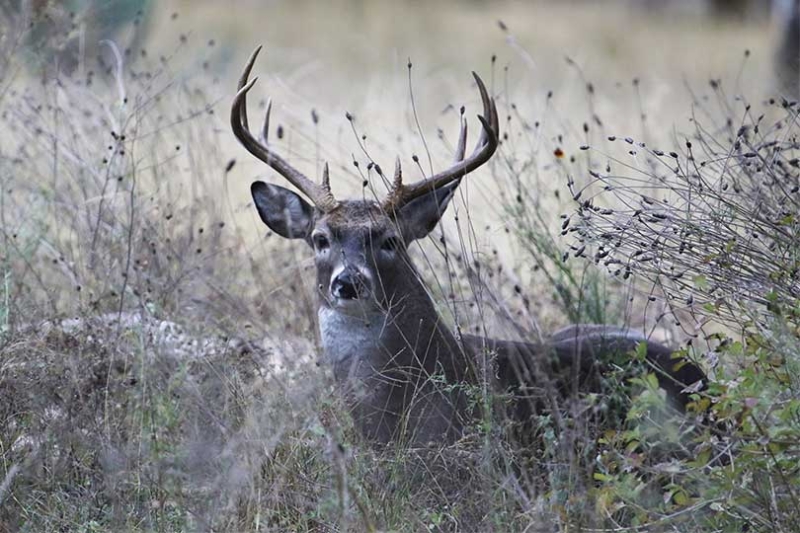By Shelby Shank
Field Editor
Texas hunters have reason to be optimistic as they gear up for the 2025 white-tailed deer season.
According to the Texas Parks and Wildlife Department (TPWD), healthy deer populations, strong fawn survival rates and an increasing number of mature bucks are contributing to this year’s outlook that is expected to be average to above average across the state.
“The saying ‘everything is bigger in Texas’ can certainly apply to Texas deer hunters and its deer population,” said Blaise Korzekwa, TPWD white-tailed deer program leader. “Even an average year in Texas is worth hunting.”
Texas leads the nation in the number of deer hunters, total harvest and overall white-tailed deer population.
Last season, hunters had a 67% success rate, harvesting about 837,000 deer, with 51% being bucks and 49% does, according to TPWD. Similar numbers are expected this fall, with increasing doe populations offering even more opportunity.
Hill Country
The Hill Country continues to have the highest population density in the state.
Despite severe flooding in early July, TPWD biologists believe most deer were able to escape to higher ground, and overall impacts on the deer population should be minimal.
However, recent rains came too late to drastically boost antler growth, but mild summer temperatures and improved vegetation in a prolonged drought will likely support strong fawn survival.
Hunters focusing on areas like Llano and Mason counties, where deer densities are highest, should expect to encounter a healthy number of bucks in the 4½ to 5½-year-old range.
South Texas
South Texas is known as the premier big buck destination in the state and has an estimated population of 527,000 white-tailed deer.
While most of the region remains under severe or extreme drought, some areas received timely rainfall in the spring that could potentially boost antler development and overall herd health.
Properties managed for older age-class bucks are expected to benefit the most. Last season, 56% of the buck harvest in the region was made up of deer 4½ years or older. Hunters targeting South Texas ranches may see some of the best mature buck opportunities in the state again this year.
Post Oak region
The Post Oak region is also showing signs of a productive season ahead.
The northern part of the region received beneficial spring rainfall, which should help with fawn recruitment and overall deer health.
In 2024, 42% of harvest bucks in the region were 4½ years or older, setting a record for the area.
Although drought conditions persisted in the southern portion of the region, mature buck sightings and harvest opportunities are still expected to be solid, particularly for deer at least 4½ years old.
East Texas
In East Texas, the population has remained stable at around 327,000 deer for the last four years.
Overall densities can be modest in some parts of this forested region, but habitat-managed properties often see much higher concentrations.
The highest numbers remain near Tyler, and local areas that practice sound deer management can exceed 40 to 50 deer per 1,000 acres.
In 2024, 29% of harvested bucks were 4½ years old or older and also set a record for this region.
TPWD advises hunters to be selective this year, as the middle-aged bucks are thinner and will be important to future mature harvests.
Cross Timbers region
The Cross Timbers region boasts the second-largest deer population in Texas at nearly 788,000 deer.
Poor fawn recruitment in 2022 has led to reduced numbers of younger bucks available this season, but mature buck numbers remain strong.
The age structure is well-distributed, and with timely spring rains, harvest success is expected to mirror last years 69% success rate, according to TPWD.
Rolling Plains
Both the eastern and western Rolling Plains have experienced steady deer population growth in recent years.
Densities range from 18 to 92 deer per 1,000 acres, depending on the location.
Sporadic fawn production has created some gaps in age classes, but mature bucks remain a bright spot.
In the western portion, over 52% of bucks harvested last year were at least 4½ years old, placing the region just behind South Texas for mature buck harvest.
TPWD noted lower hunting pressure, large property sizes and increased interest in wildlife management have helped mature bucks thrive.
Harvest success in both regions hovered around 70% in 2024, and similar outcomes are expected this season.
Reminders for hunters
TPWD reminds hunters to review current regulations before heading to the field.
Hunters are encouraged to check the Outdoor Annual or OutdoorAnnual.com for full deer hunting regulations, information on chronic wasting disease zones and mandatory harvest reporting.
The archery-only season in most counties begins Sept. 27 and runs through Oct. 31.
General season opens Nov. 1 and runs through Jan. 4 in the North Zone and Jan. 18 in the South Zone.


Leave A Comment